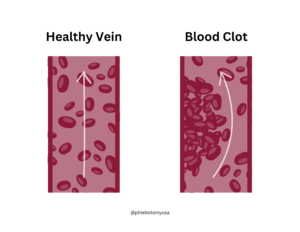10 Apr Debunking 8 Myths About Blood Clots
Blood clots are a significant medical concern, causing an estimated 300,000 deaths annually in the United States alone. Their impact on global health and well-being is profound. This article aims to clarify common misconceptions, highlighting the risks, causes, and the critical role of education in managing this widespread health issue.
Myth 1: Only older or sick people get blood clots.
Fact: Anyone can get a blood clot, even if young and healthy.
While age and illness can increase the risk, blood clots do not discriminate by age or overall health. Young, active individuals can also develop blood clots, particularly if they have certain genetic predispositions or are in situations that reduce blood flow, like long flights or periods of immobility.
Myth 2: Blood clots are not a big deal.
Fact: Clotting can be serious.
Blood clots, particularly deep-vein thrombosis (DVT), are a serious health concern. DVT often originates in the legs and can become life-threatening if a clot dislodges and travels to the lungs, causing a pulmonary embolism. It’s estimated that up to 30% of people with untreated DVT could develop a pulmonary embolism.
Myth 3: I won’t get a blood clot.
Fact: Blood clots can affect anyone.
No one is immune to clotting. Risk factors include surgery, cancer, heart or lung disease, hormonal birth control, and a family history of DVT. Lifestyle factors like prolonged immobility, obesity, and smoking also play a significant role.
Myth 4: I don’t need blood thinners if I don’t have a clot.
Fact: Blood thinners may be necessary even if you don’t have a clot.
Blood thinners are often prescribed as a preventive measure, especially for individuals at high risk of clot formation, such as those with atrial fibrillation or previous clot incidents. These medications help reduce the risk of new clots forming.
Myth 5: Blood clots mostly happen at home or during travel.
Fact: Blood clots are more common in hospitals than anywhere else.
While travel-related DVT, known as “economy class syndrome,” is a known risk, hospitals are a more common setting for clot development. Immobility during recovery, certain medications, and the presence of other risk factors contribute to this increased risk.
Myth 6: I’m healthy and active, so I don’t need to worry about DVT.
Fact: Anyone can get DVT, including athletes.
Being healthy and active reduces the risk but does not eliminate it. Athletes, for instance, can be at risk due to injuries, dehydration, or long periods of immobility during travel. Vigilance is key, regardless of fitness level.
Myth 7: Birth control pills always cause blood clots.
Fact: Most women on birth control pills do not experience blood clot-related complications.
While hormonal birth control slightly elevates the risk of clotting, the overall incidence in women taking these pills remains low. Factors like obesity, age, smoking, and individual health history are significant contributors to the risk.
Myth 8: Women are at the highest risk for blood clots.
Fact: Men have a higher chance of getting DVT and pulmonary embolism (PE) than women.
Studies indicate that men have a higher incidence of DVT and pulmonary embolism (PE) than women. Hormonal factors and lifestyle choices could contribute to these differences.
Conclusion
Dispelling myths and spreading accurate information about blood clots is vital. Awareness is critical in promoting early detection, timely treatment, and preventive measures. Clotting can affect anyone, making universal education on this topic a public health priority for better outcomes.


